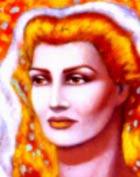|
A blue flower blooms on the fiery red rocks, but
are they rocks? Or rather a sea of red lava, speckled with gold, from which the Diva and
the Unicorn appear. A fiery horizon is dappled with precious sparkling features,
reflection of a volcanic and dusty river of turquoise and gold. Circles of light explode
in the centre which announces the descent of the igneous ephebe, tailed flames, shiny and
metallic in the incandescence of its flaring element. A sun with blazing sparks
deflagrates the heart of the Unicorn melting his virginal pride and She, the Diva, moving
within her cloak of purity, already averts the rising of the fiery flames, the heat of her
red and gold silky cloak, the lining of her white dress is encrusted with fragments of
gold and suffers the blaze which makes her hair the colour of bronze and her lips
embellished by a laminated gloss. On her head lies a crown of blazing fire, leaving her
golden magma intact.
In this burning annunciation the sublime knowledge of the immutability of the mythical
body is exalted as it burns without being consumed and melts into the sea of fire never
losing, even in the cruelty of a telluric and crushing event, the capacity to recognise
itself.
Oracles and revelations or different worlds beyond the curtain
(Medea, Rivelazione)
A figure closed in a cocoon of material, intent, taut in the act of divinatory
understanding awaits the opening of the motionless barrier. It is Medea, the enchantress,
who calls upon her sorcery, the revelation. The compact architecture of the urban towers
seems to have not yet lost its geological tracts, even if the red and gold sunset
illuminates the sky, so full of fiery planets and lava milky ways. This is the prelude to
revelation, but as soon as time approaches epiphany, the terrestrial worlds open to the
plight of an implacable ray of cold light; and where this light shines, there, on the
cliffs of the lava rock, it creates craters of ardent snow from which flow precious
liquids and humours. On the balcony of the terrestrial worlds, now melted by the embers of
white heat, the oracle Genie appears in order to lift the veil. Other nature, other
spaces, and morphologies characterise the revealed world; the other world, the first, has
disappeared behind a red and gold flow of colour which glows in the background.
Terrestrial Architecture. Surrender under the attack of beauty
(Interludio, Algida Voce, Il Bel Canto)
They are immobile, solidly built thick walls. They have the neutral consistency of
timeless buildings occupying measurable and tangible space. They can be interpreted
according to safe and validated characterisations, aqueducts, towers, propylacums and
barred windows. They seem to be unattackable and incorruptible but they collapse in front
of Beauty and in front of the enchantment of the Sorcery; their theorem and their enigmas
are continuously made vulnerable by the fire of the sentimental worlds, where it is not
the strength of design, decree of execution or mathematical reason that rules. Golden
drills penetrate them; precious swarms of insects corrode them, flames set on fire by
shiny cold light destroy them, men bound by red ribbon on black horses split them apart
until their impassivity shivers and they feel the impelling transformation. An ionic
capital of golden metal lengthens with intemperance, revealing its shape and sense; it
becomes oneiric and surreal, conquesting liberty of expression surrendering to the love
that fluidifies the cosmos. Stars illuminate with laser beams the organised structure of
the city of man and reduce them to exploding galaxies. Eluding the prisons of the world,
the hidden beauty leaps out with a burst of energy, no longer secluded, and flies towards
its sky of melted gold and cobalt.
The style of Giovanni Truncellito
The elaboration of an oneiric formalism takes shape for Giovanni Truncellito in his search
for a linearly taut and chromatically dense language which can be classified as visionary
impressionism. The symbolist themes - with memories and quotations by Friedrich, Bocklin,
Von Stuck, De Chirico, Savinio - are revisited in an exalted, ecstatic dimension, full of
eroticism and at the same time subtle mysticism.
The strong spirituality that this artist nurtures implodes in the images through the
exaltation of the concept of effused matter. This choice, primarily ideological, brings
about a galactic form of art, like celestial worlds which reverberate on the objective
shapes disintegrating them or dragging them into their vortices of sparks and reflections.
A formal apparatus which seems to derive from a meditation on Redon or some other
surrealists, shuffling the cards, however, until neo-Indian figurative characters are
obtained. The return to the world of opera, implicit in the name of the exhibition appears
to me to be resolvable not only in a Verdi or even Puccini nature, as some of the titles
suggest, but in syntony with a Wagnerism so very evident in the cosmic and luminous
fluidity of the pictorial works and in the continuous attempt to reach an imaginary fiery
enchantment.
Gabriele Borghini
|

|
|